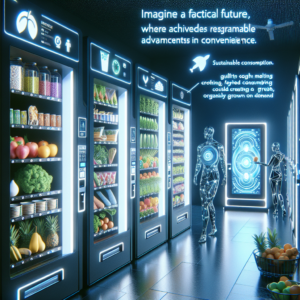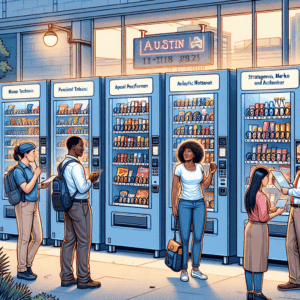The Rise of Vending Machines in Texas Workplaces
Early Beginnings
When vending machines first started appearing in Texas workplaces, it was more like a novelty than a necessity. These were the days when grabbing a snack or a quick soda from a mechanized box seemed like a futuristic idea. I remember my first experience with one was eye-opening—tiny coins yielded an instant treat!
In the early days, vending machines in Texas were primarily stocked with simple snacks and beverages. It was an easy way for workers to grab a quick pick-me-up without leaving the office. This convenience factor is why they quickly gained popularity, particularly in larger cities such as Houston and Dallas.
As companies noticed their employees’ increasing use of vending machines, they began to incorporate them into workplace culture. What started as an experiment soon became a staple in offices, factories, and even schools across the state.
Expansion Across the Lone Star State
Once the idea caught on, it spread like wildfire. Vending machines started popping up in all sorts of places across Texas. Factory floors, corporate lobbies, and break rooms all featured these convenient little boxes. This widespread expansion caught the attention of vending machine manufacturers, turning Texas into a significant market for the industry.
From my perspective, this expansion was driven by a few key factors. Firstly, the economic boom in Texas gave businesses the budget to invest in employee amenities. Secondly, the state’s vast geographic spread made quick lunch options a valuable asset for time-strapped workers.
The rise of these machines also brought about an interesting dynamic in the workplace. Employees had a new meeting point—a place to gather, chat, and occasionally discuss work issues in a relaxed setting.
Iconic Brands and Products
Oh, and let’s not forget the brands! Iconic Texas favorites like Dr Pepper and Big Red became mainstays in vending machines. Whether it was due to the regional pride or the fact these beverages were just really tasty, they were often among the top sellers.
Seeing vending machines stocked with local favorites made them feel a little less like anonymous snack boxes and more like a shared workplace asset. They offered a quirky glimpse into Texas culture, with regional snacks that made employees feel more at home.
As time went on, vending machines began to diversify their offerings. Health-conscious options started appearing alongside the snacks and sugary drinks, reflecting shifts in societal attitudes toward health and wellness.
The Cultural Impact of Vending Machines
Social Gatherings and Break Room Culture
Back in the day, vending machines were a catalyst for social interaction in the workplace. Employees would naturally congregate around them, not just to buy a snack, but to chat and take a mental break from the day’s work. It became a common scene and an informal meeting spot.
From my experience, this contributed significantly to team-building. Coworkers who might not see each other during the day otherwise got a chance to interact. It was an organic way to grow friendships and enhance work collaboration.
Over time, lunch breaks or quick coffee runs became more about the connections formed around the machine than the snacks themselves. I’ve seen some exceptional team dynamics forged right at the vending machine.
Influence on Workplace Productivity
It wasn’t all just chit-chat, though. Vending machines contributed to enhancing workplace productivity too. Having quick access to snacks and beverages meant employees spent less time away from work. This change, however small, gradually affected overall productivity positively.
The convenience of these machines also improved employee satisfaction. Workers felt valued when their needs were anticipated, and fulfilling a craving within arm’s length definitely played a role in that.
For management, implementing vending machines became a no-brainer. It was a low-cost way to ensure employees were comfortable and pleased, which in turn benefited the company as a whole.
Driving Healthy Choices
In recent years, there’s been a noticeable shift towards healthier options in workplace vending machines. I recall when the first few low-sugar drinks and granola bars started appearing—it was a breath of fresh air for many nutrition-conscious employees.
Manufacturers and management began to recognize the importance of health, leading to agreements to stock more nutritious options. This change reflected larger societal trends toward health awareness and lifestyle changes.
Healthy options also fostered healthy discussions at the workplace. Employees began sharing insights and recommendations about healthy choices, promoting a culture of health and wellness that extended beyond the workplace.
Behind the Snack Glass: Maintenance and Challenges
Logistics of Stocking and Maintenance
One thing we often take for granted is the effort that goes into keeping vending machines functional. In my experience, stocking and maintaining them is a logistical challenge. It requires precision in restocking, ensuring all items are fresh and shelved appropriately.
It’s a shared responsibility between vending machine suppliers and the host company. Proper coordination is crucial to prevent stockouts and ensure employees have access to their favorite snacks and drinks.
I learned that prompt maintenance was essential, too. Any malfunctioning machine required immediate attention to avoid dissatisfaction, and companies had to set up reliable systems for quick repairs.
Technological Advances Over Time
From the rudimentary coin slots to today’s advanced touch screens and mobile payment options, vending machines have come a long way. I remember the first time I was able to buy a soda using an app; I thought it was the coolest thing ever!
These technological advancements have made vending machines even more accessible and convenient. Touch screen interfaces, card readers, and options to pay by phone are just some of the features that have modernized these devices.
Yet, these advances haven’t come without their challenges. Upgrading machines requires a significant investment, and companies often have to weigh the benefits against the cost.
Addressing Theft and Vandalism
It’s unfortunate, but vending machines have often been targets for theft and vandalism. I recall facilities staff discussing ways to combat these issues through better security and monitoring systems.
The trick is balancing accessibility with security. Measures such as surveillance cameras and strategic placement of vending machines helped reduce these unwanted incidents effectively over time.
Nonetheless, addressing such challenges involves continuous efforts and adaptability as new issues arise with technological advancements. It’s an ongoing process to ensure that this valuable workplace amenity remains available and secure.
Vending Machines as a Catalyst for Workplace Change
Revolutionizing Break Times
Vending machines have revolutionized the concept of break times by offering varied options within a few steps from one’s desk. This convenience has allowed employees to maximize their break time for relaxation rather than running to and from a café or snack shop.
In my experience, this small change made a big difference in how employees utilized their breaks. Instead of rushing, they could unwind and truly enjoy their down time, which naturally resulted in a more refreshed, focused return to work.
This shift in break time dynamics also reflects evolving workplace expectations. Employers increasingly recognize the importance of providing amenities that positively impact work-life balance.
Adapting to Dietary Trends
Dietary trends and preferences have made a mark on the kind of items available in vending machines. I’ve seen significant changes—from sugar-laden snacks to gluten-free, vegan, and other specialty options that cater to a wide range of dietary requirements.
With an increase in food sensitivity awareness, vending machines expanded their offerings to accommodate more employees, resulting in greater inclusivity. This adaptation has been well-received and demonstrates how workplace amenities evolve in response to changing societal preferences.
For businesses, this trend indicates the importance of flexibility and awareness. It’s about staying relevant by offering products that align with employees’ modern lifestyles and expectations.
Fostering Community and Collaboration
One of the unexpected benefits of vending machines has been their role in fostering community and collaboration within the workplace. They provide a shared resource for teams, promoting interaction among people who may not work together directly.
I’ve always found that a quick chat over a vending machine snack break can lead to unexpected insights and collaborative opportunities. It breaks down barriers and encourages spontaneous discussions that can lead to innovative solutions.
Creating community and promoting collaboration is vital in any thriving workplace. Vending machines, as simple as they are, contribute to this by being a common ground where employees come together regularly.
FAQ
How did vending machines become popular in Texas workplaces?
Vending machines gained popularity in Texas workplaces due to their convenience and increased accessibility of snacks and drinks without leaving the office. This became crucial in larger cities, driving widespread adoption.
What cultural impacts did vending machines have in workplaces?
Vending machines affected workplace culture by providing social gathering spots, enhancing productivity, and sparking health-centric conversations and practices among employees.
What challenges were faced in maintaining vending machines?
Challenges included ensuring timely restocking and maintenance, addressing technological needs for upgrades, and handling issues related to theft and vandalism.
How did vending machines adapt to new workplace trends?
Vending machines adapted by incorporating healthier food options, embracing new payment technologies, and diversifying offerings to meet modern dietary preferences and lifestyle changes.



